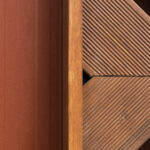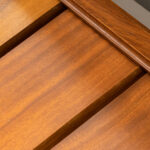
As a homeowner or contractor, one of the most important decisions you will have to make is choosing the right building material for your project. Two of the most popular options are block board and plywood, each with its own unique set of benefits and drawbacks. In this article, we will compare block board vs plywood and help you decide which material is the best fit for your specific application.
What is Block Board?
It is a type of engineered wood made by gluing together strips of softwood, such as pine or spruce. The strips are placed edge to edge, sandwiched between two layers of hardwood veneer, and then glued together under high pressure. Block board is typically used for indoor furniture, partitions, and other decorative applications.
What is Plywood?
Plywood is a type of engineered wood made by gluing together thin sheets of wood veneer. These veneers are usually made from hardwoods, such as birch, oak, or maple, and are glued together with their grains running perpendicular to each other. This cross-grain construction gives plywood its strength and stability. Plywood is used in a wide range of applications, including construction, flooring, and furniture making.
Comparison Of Block Board vs Plywood
- Strength and durability: Plywood is generally stronger and more durable than the board due to its cross-grain construction. However, the board can be made more durable by using high-quality glue and hardwood veneer.
- Cost: Block board is generally cheaper than plywood, especially if you are using softwood strips. However, the cost can vary depending on the quality of the materials used.
- Weight: Block board is generally lighter than plywood, making it easier to handle and install.
- Appearance: Block board has a more uniform appearance than plywood due to its edge-to-edge construction. Plywood can have a more natural and varied appearance due to the different grain patterns of the veneers used.
Block Board vs Plywood: Applications

Block board is typically used for indoor furniture, partitions, and other decorative applications. It is ideal for making shelves, cabinets, and other storage units due to its lightweight and low cost. It is also used in the construction of doors and panels.
Plywood is used in a wide range of applications, including construction, flooring, and furniture making. It is ideal for use in areas where high strength and durability are required, such as in roofing and flooring. It is also commonly used in the construction of walls and ceilings.
Block Board vs Plywood: Benefits
Here check the Benefits of Block Board and Plywood:
Benefits of Block Board
Lightweight
It is generally lighter than plywood, making it easier to handle and install. This can be especially advantageous when working on projects where weight is a concern, such as in furniture making or in the construction of mobile homes or boats. The reduced weight of the board also makes it easier to transport, which can save on shipping and handling costs.
Cost-effective
It is generally cheaper than plywood, especially if you are using softwood strips. This can be a major advantage if you are working on a project with a tight budget. However, it’s important to note that the cost of a board can vary depending on the quality of the materials used, so it’s important to compare prices and quality before making a purchase.
Uniform appearance
It has a more uniform appearance than plywood due to its edge-to-edge construction. This makes it a popular choice for projects where a smooth, uniform surface is desired, such as in cabinetry or furniture making. Additionally, the surface of the board can be easily painted or finished to achieve the desired look.
Resistant to warping
It is less likely to warp than plywood due to its construction. The solid wood strips used in the board provide more stability and rigidity than the thin veneers used in plywood. This can be an important consideration for projects where stability and durability are a concern, such as in the construction of doors or outdoor furniture.
Sound insulation
It has better sound insulation properties than plywood due to its construction. The solid wood strips in the board help to absorb sound waves, making it a popular choice for soundproofing applications such as in recording studios or home theaters.
Better resistance to moisture
It is generally more resistant to moisture than plywood due to its construction. The use of solid wood strips and high-quality glue helps to prevent moisture from penetrating the board and causing damage. This can be especially important for projects where the board will be exposed to moisture, such as in bathroom or kitchen cabinets.
Benefits of Plywood
Strength and durability
It is generally stronger and more durable than block board due to its cross-grain construction. The layers of the veneer are glued together in alternating directions, which gives ply its strength and stability. This makes plywood an ideal choice for high-stress applications where strength and durability are important, such as flooring, roofing, and exterior cladding. However, it’s important to note that the quality of the ply can vary depending on the type of glue used and the thickness of the veneer layers.
Versatile
It is a versatile material that can be used in a wide range of applications, from furniture making to construction. It can be easily cut and shaped into different sizes and shapes, and it’s available in different grades and thicknesses to suit different applications. For example, furniture-grade plywood has a smooth finish and is ideal for making high-quality furniture, while construction-grade plywood is thicker and stronger and is used for building structures such as walls and roofs.
Natural look
It can have a more natural and varied appearance due to the different grain patterns of the veneers used. This can add character and warmth to a space, making it a popular choice for interior design applications such as wall paneling and furniture. The natural look of plywood can also be enhanced with staining or painting, allowing for further customization.
Resistance to moisture
It can be treated to resist moisture, making it ideal for use in areas where water damage is a concern. Marine-grade plywood, for example, is specially treated to resist rot and decay caused by exposure to water and moisture. This makes it ideal for use in boat building and other outdoor applications where moisture is a concern.
Fire-resistant
It can also be treated to be fire-resistant, making it a safe choice for use in applications where fire protection is important. Fire-retardant plywood is treated with chemicals. It slow down the spread of fire, reducing the risk of damage and increasing safety.
Sustainable
It is a sustainable material that is made from renewable resources. It’s made from thin layers of wood veneer that are cut from sustainably managed forests and glued together with non-toxic adhesives. This makes it an environmentally friendly choice for builders and designers.
Cost-effective
It is generally more cost-effective than solid wood or other materials, making it an affordable choice for a wide range of applications. It’s available in a variety of grades and thicknesses to suit different budgets. You can easily source it from most building supply stores.
Block Board vs Plywood:Drawbacks

Here check the Drawbacks of Block Board and Plywood:
Drawbacks of Block Board
- Not as strong as plywood: It is not as strong or durable as plywood, making it less suitable for high-stress applications.
- Limited applications: It is typically only used for indoor furniture and decorative applications.
- Not suitable for moisture-prone areas: It is prone to warping and swelling when exposed to moisture.
Drawbacks of Plywood
- More expensive: It is generally more expensive than block board, especially if you are using high-quality hardwood veneers.
- Heavy: It is generally heavier than block board, making it more difficult to handle and install.
- Prone to splitting: It can split easily if not cut and installed properly.
Block Board vs Plywood: Which One to Choose?
The choice between block board and plywood ultimately depends on your specific application and budget. If you are looking for a low-cost, lightweight material for indoor furniture or decorative applications, block board may be the better choice. However, if you need a strong, durable material for construction or high-stress applications, plywood is the way to go.
Factors to Consider Before Choosing Block Board or Plywood
Before making your final decision, there are several factors to consider:
- Strength and durability requirements
- Moisture resistance requirements
- Weight limitations
- Appearance preferences
- Budget
By taking these factors into consideration, you can make an informed decision about whether block board or plywood is the right choice for your project.
Conclusion
Block board and plywood are two popular building materials that have their own unique benefits and drawbacks. While block board is a low-cost, lightweight option for indoor furniture and decorative applications, plywood is a strong, durable material that is ideal for construction and high-stress applications. When choosing between these two materials, consider your specific application, strength and durability requirements, moisture resistance needs, appearance preferences, and budget.
FAQs
The board is made by sandwiching strips of wood between two thin sheets of veneer. But plywood is made by layering thin sheets of wood veneer together in alternating directions.
Ply is generally better for outdoor use as it is more durable and resistant to moisture than the board.
Yes, a block board can be sanded and painted just like ply, but it is important to ensure that the surface is smooth and free from defects before applying paint.
The board is generally more affordable than ply, but the price may vary depending on the quality and type of wood used.
Ply is generally more versatile than the board as it can be used in a wider range of applications, from construction to furniture making.
Yes, most block board manufacturers can customize the size and thickness of the boards to meet the specific needs of their customers.
Some factors to consider when choosing a block board supplier include the quality of their products, their delivery times and reliability, their pricing, and their.
Block board manufacturers in India commonly use hardwoods like teak, oak, and maple for the solid block at the core of the board, as well as softwoods like pine and fir.



